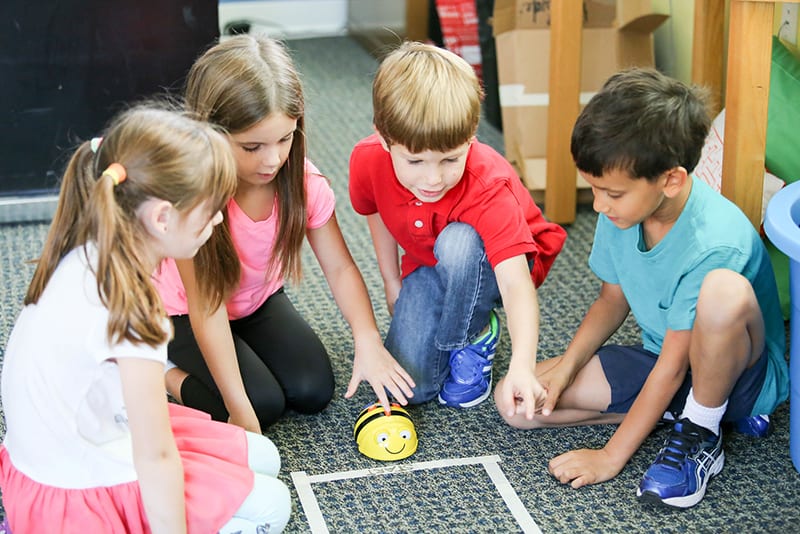In her classroom which has a very open design with bright colors, cushions, pillows, and “soft spaces” conducive to creativity, Ms. Kahn has “Coding Vocab Words” displayed prominently, one of which is featured in class each week. Some examples: Algorithm, Program, Language, Pair Programming, Persistence, Sequencing, Loop, Debugging, Pattern Matching, Conditionals, Binary, Event, Function, Variable, Decompose, Abstraction.
“Algorithm – A list of steps that you can follow to finish a task.”
“Sequence – A set of events, things, or movements that follow each other in order.”
“Persistence – Trying again and again, Even when something is hard.”
MFS is one of the few schools in the United States to provide Coding classes to all Lower School students, including preschoolers. The course is part of the Lower School’s “specials” rotation that also includes Art, Music, Physical Education, Library, Quaker Education, Computer Science. Students participate in Coding class twice every six days. The program also extends into Grade 5 (Middle School).
“Whether your child becomes a doctor, chemist, librarian, lawyer, or computer programmer, he or she will be equipped with valuable computational thinking, problem-solving, and teamwork skills developed from an early age through this program.” said Lower School Director Kelly Banik.
Full-time Coding Teacher Liz Kahn has a master’s degree in elementary education from the University of Pennsylvania and a B.A. in psychology from Temple University.
“This is the language you need to speak to technology,” said Kahn. “The foundation of coding is algorithms, which translate to programs. For instance a step-by-step process to brush your teeth is an algorithm that you use everyday.”
Teamwork and collaboration skills are constantly being developed in Coding classes. Programmable robots with names like “Beebot,” “Dash,” and “Dot” are often used for lessons and problem solving. “There is a lot of group work and paired programming,” said Kahn. “A large amount of trial and error takes place and it works well when there is a ‘driver’ who is operating the technology and a ‘navigator’ who is talking through the sequence.”
The goal is to prepare Moorestown Friends students for a world that is heavily reliant on technology.
“We are teaching our students to understand technology beyond the interface (iPhone, tablet, etc.) level,” said Kahn. “Our students are going to be able to build, and understand what’s behind, interfaces and interact with technology on a much higher level.”
The Lower School Coding program evolved from a schoolwide Strategic Planning process which identified possible additions and alterations to the curriculum in the areas of 21st century skills and Science, Technology, Engineering, and Mathematics (STEM).
“We’re constantly assessing our curriculum and this program has already demonstrated the ability to build persistence and resilience in our students,” said Banik. “So, in addition to the obvious computer science skills that this program develops, our students are being equipped with tools necessary for a 21st century professional.”
For resources and additional information about Coding, please visit code.org.

